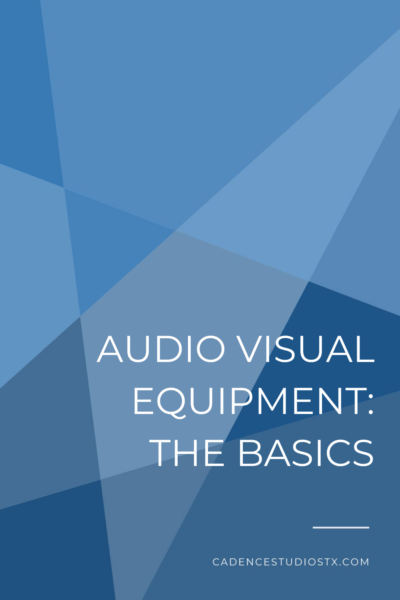Audio Visual Equipment: The Basics
Knowing the basic components that make up audio visual will help you greatly in your search for a company that can meet your event planning needs. Below you will find a concise guide to the most important equipment pieces and their main purposes!

Speakers
Audio Visual companies almost always refer to speakers as PA loudspeakers and they are broken into four primary categories: Mains, subwoofers, stage monitors, and line arrays. Mains, the topmost speaker, function as the primary and produce most of the frequency range. Subwoofers, the bottom speaker, fill out the sound of the system and boost the lower bass frequencies to create a more powerful sound. Stage monitors do not face the audience but the performer on stage instead, providing them audio to hear themselves. Lastly, line arrays are a different class of PA systems made of several identical loudspeaker elements mounted in a line that is flown or rigged from the ceiling.
Microphones
Microphones come in all different shapes and sizes with a multitude of applications. Deciding between wired or wireless depends on the performer and their movement. If a perform will be moving quite a bit, wireless would be the way to go, whereas if they are stationary a wired mic will be more than adequate. Lavalier microphones, also known as lapel or body mics, are smaller microphones used for television and public speaking applications to allow a hands-free operation. Lastly, headsets are also a hands-free microphone but offer a higher quality sound, the con being that they are more visible than the smaller lapel mics.
Projectors and Screens
Projection systems project any visual onto a screen or wall and are without a doubt a critical part of any presentation. Almost all modern projectors can project onto a screen that is either in front of or behind the intended audience with no quality loss. However, keep in mind the room you will be using to project because if the audience is going to be situated in front of the screen, it will be best for a rear projection instead of a front projection. In addition to the layout, you need to know whether the elements you are planning to project will require an HD or SD projector. HD projectors have a standard aspect ratio of 1080p while SD projectors are most commonly 480p. You will not always need an HD projector and can save money by using a simpler SD projector.
Drapery and Lighting
Some AV companies are full-service and will also provide draperies and lighting. Draperies are a simple and elegant way to transform any event space with fabrics draped and arranged to accomplish what you are looking for. Like AV equipment, lighting has many types and uses and is most commonly tasked to someone who is skilled primarily in knowing the different systems.
These are the most common pieces of equipment and most likely to be discussed while planning out your event with your chosen AV company. Don’t be afraid to always ask for more details one what equipment is in use and what other services can be provided!




